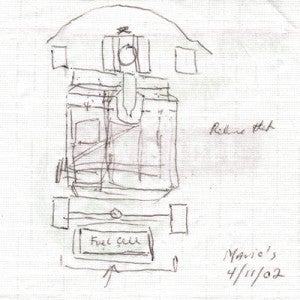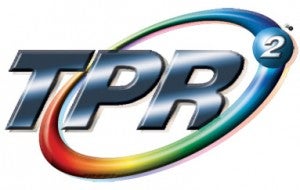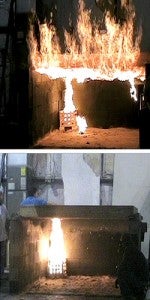Flame Proofing to a Higher Power

As he sat at dinner in Mario’s Place in Westport, Conn., in 2002, Peter Gummo ’83 saw the future of fire safety as he stared at his napkin.
On the napkin was a sketch of a professional race car. The artist of the drawing, an acquaintance of Gummo’s, was pitching a potential investment and explaining how he knew of a Russian-born scientist who was working on a specialized coating that could keep race car drivers safe during a crash by preventing oil fires.

That sketch—which now resides in a frame on the wall of Gummo’s office—was the genesis of the company Thermal Protection Technology (better known as TPR2) and the successful collaboration among Gummo, the physicist-inventor Felix Dimanshteyn, and product development engineer Rick Barone.
As president of the Waterford, Conn,.-based company, Gummo has seen TPR2 (pronounced TPR squared) grow from a sketch to a major player in the fire safety industry in just a few short years.
 The company is a leader in the development of revolutionary products not only used by NASCAR and the National Hot Rod Association (NHRA) but also in the construction, entertainment, and aerospace industries.
The company is a leader in the development of revolutionary products not only used by NASCAR and the National Hot Rod Association (NHRA) but also in the construction, entertainment, and aerospace industries.
The company’s success story begins on the car racing circuits with the revolutionary coating Temprotex. The thin, ultra-low VOC, water-based coating can be sprayed like paint over car engine parts to provide a fire barrier that keeps flammable substrates like carbon fiber and polyurethane foam from igniting.
“It’s a latex-based product, so it’s green and environmentally friendly,” Gummo said. “It’s very easy to use. It goes on like paint—it’s that easy to apply. We use airless spray guns, rollers, or brushes.”

Testing: Thanks to Temprotex, a thin, water-based coating that can be sprayed over car engine parts as a fire barrier, the fire at the bottom above can barely burn; without the coating, the fire on the top above flames out of control.
“If there’s an accident or engine failure in a race, there’s a possibility of hot oil, which can ignite,” explained Gummo. “Our product actually extinguishes liquid-based fires. When you see this material in action, it’s impressive.
“The relationship with NASCAR and NHRA has done a tremendous amount for us,” Gummo said. “NHRA mandated Temprotex for its racers.”
By 2004, TPR2 was being used to coat vehicles and engine parts of several NASCAR® racing teams and was growing in popularity, especially after it was featured on Fox Sports. “That exposure has led us from professional motor sports to projects in construction and aerospace safety,” said Gummo.
Dimanshteyn, who developed the technology used in the coating, came to the U.S. in the mid-1980s after working with the Russian Army to develop products designed to thwart the impacts of napalm (a gel-based flammable liquid used in warfare). After learning how Dimanshteyn was able to combat the effects of napalm with his special coating, Gummo asked him if he could develop a technology that could be used to prevent liquid-based fires.
“He had been working with fire retardant technology for a long time, and we could see the potential for other uses,” Gummo said. “However, it was a conceptual technology and not yet a product.”
This is where Gummo and his experience came into play. After graduating from URI with a degree in political science, he married his college sweetheart Marci Reichman ’82 and moved to Connecticut. After graduating from law school, Gummo worked as an attorney specializing in finance and business development.
In the 1990s, he left the practice of law to focus his attention on the entrepreneurial aspects of business development and began purchasing and developing businesses in the U.S. and abroad. After many years of overseas travel (he also served as a trade representative for Kenya), he turned his attention to developing technologies. It was the combination of this interest and his entrepreneurial spirit that led to his decision to focus on TPR2.
With NASCAR as the initial target because of the danger of burning oils causing fast-spreading cockpit fires, Gummo licensed the technology for testing in 2003. Working with Dimanshteyn, who is still with TPR2, Gummo made sure the technology worked in other areas and then purchased it with his partner, Barone.
TPR2 is branching into other areas, such as providing better fireproofing for residential and commercial buildings. One of the key products the company is focusing on this year is a coating for polyurethane spray foam insulation that is used to create thermal and ignition barriers for buildings.
The company’s Fireshell® product was the only “green” water-based coating to pass the National Fire Protection Agency’s 286 full-scale room corner test over both open and closed cell foams in 2008. The spray was used to coat an enclosed 12-foot-by-8-foot, wood-studded room with 4.5 inches of exposed cell foam. A fire was set, and after 15 minutes of burning, the flames had not spread and there was no excessive smoke.
The coating expands up to 2,000 times, going from 14 thousandths of an inch to several inches thick when exposed to extreme heat or flame. While there is some charring, there is only limited smoke or fire buildup.
When sprayed on insulation material used in attics and crawl spaces, Gummo’s coating can replace sheetrock. This makes home building less expensive since it costs less to use the TPR2 coating than it does to install sheetrock. Because of the way the coating is applied, the builder can meet fire safety regulations without the difficulty and expense of structural modifications that come with other means of protection. And the product can be applied rapidly, which provides significant labor savings.“It’s going to be very cost-efficient for home builders,” Gummo said. “You get the benefit of the spray foam insulation, which is a much better insulator, and there are no air pockets, so fire doesn’t get a chance to breathe.”
TPR2 products , which are subjected to intense testing, meet regulations set by the International Code Council Urban-Wildland Interface Code. In areas prone to wildfires, the spray can help slow and retard the spread of flames.
The products also are safe for use on oil rigs, boats, and ships, as well as industrial and mining sites. And the company is also researching anti-explosive technology that could provide more advanced safety products down the road.
“We’re always looking for new ways to make use of our technology,” said Gummo who, with Marci and their two teenage children, divides his time between homes in Saunderstown, R.I., and Savannah, Ga.
By Shane Donaldson
 Home
Home Browse
Browse Close
Close Events
Events Maps
Maps Email
Email Brightspace
Brightspace eCampus
eCampus


